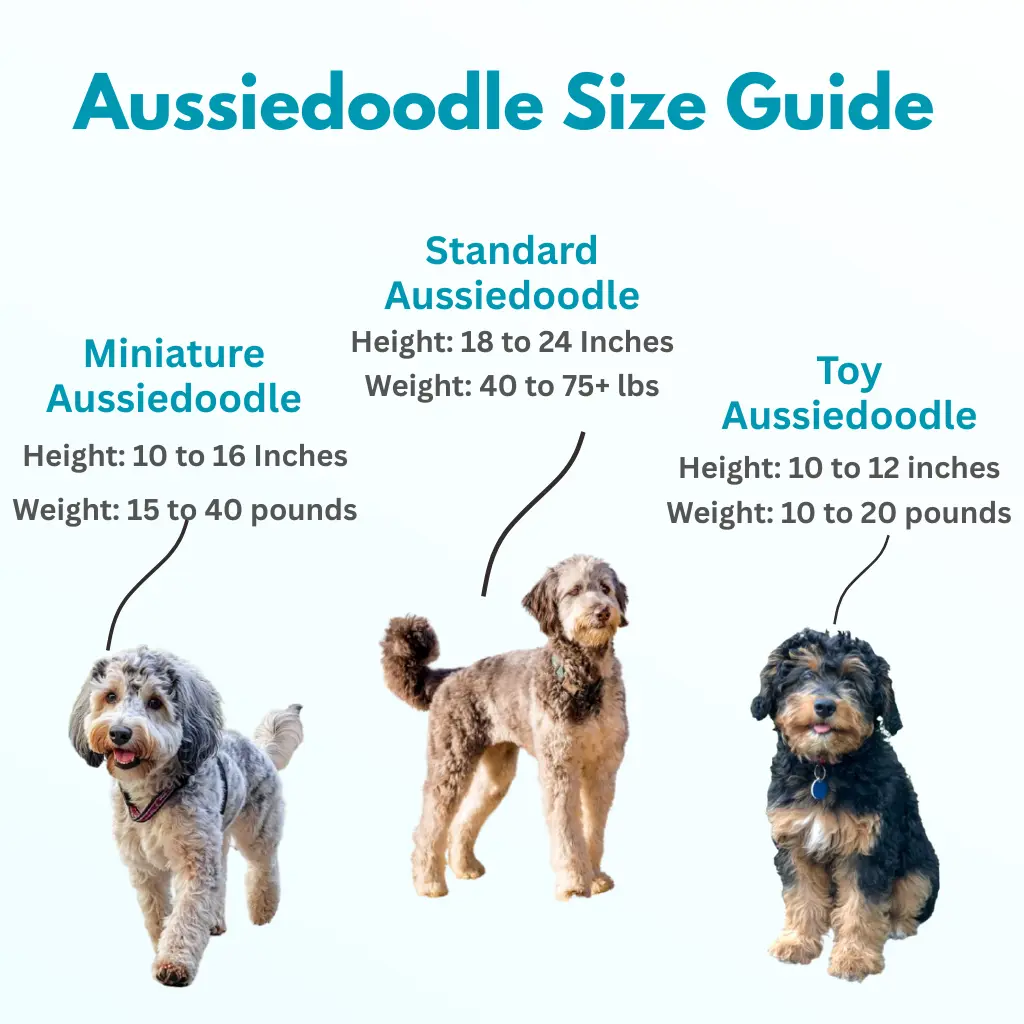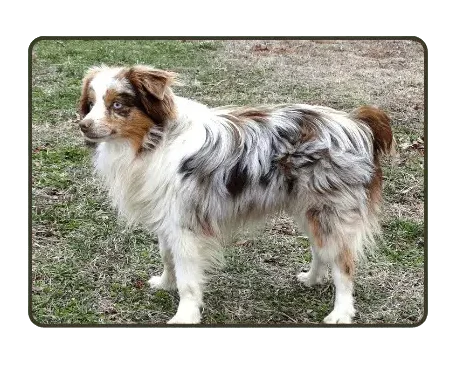
Enjoy Free Delivery Anywhere in the USA
Petsay
The Aussiedoodle is a fun-loving, highly intelligent crossbreed between a purebred Australian Shepherd and a purebred Poodle. These dogs are known for their playful, affectionate, and active personalities, making them great companions for families and individuals alike.
Whether you’re looking for a loyal family pet, an adventure buddy, or a dog for canine sports, the Aussiedoodle brings the best traits of both parent breeds into one smart and affectionate companion.
18 to 24 Inches
40 to 75+ lbs
10 to 15 years

Generally healthy dogs. However, regular vet check-ups, a good diet, and plenty of exercise are important.
Smart, low-shedding, family-friendly companion dog
The Aussiedoodle originated in the United States around the late 1990s to early 2000s

Exercise Needs
Active Explorer
Health Issues
Strong & Resilient
Grooming Needs
Fluffy Maintenance
Training Needs
Quick Learner
Shedding Level
Light Shedding
Friendliness
People Lover
Playfulness
Forever Fun
Energy Level
Always On-the-Go
Apartment Living
Compact Friendly
Cold Weather Tolerance
Mild Chiller
Warm Weather Tolerance
Summer Ready
First-Time Owner Suitability
Beginner Friendly
Good with Kids
Family Favorite
Good with Cats
Feline Friendly
Good with Other Dogs
Pack Buddy
First-Time Owner Suitability
Beginner Friendly
They started as Basque herding dogs called Pyrenean Shepherds in Europe. These dogs were taken to Australia for sheep work and later to California, where ranchers mistakenly thought they were from Down Under — and that’s how they got their name. Soon, Aussies became stars in Western movies, rodeos, and ranch life.
The Poodle, often thought to be French, was actually developed in Germany. Originally bred to retrieve ducks from cold water, their intelligence and elegant looks later made them popular family pets. The Australian Shepherd joined the AKC herding group in 1993, while Standard and Miniature Poodles joined the AKC non-sporting group in 1887.
The Aussiedoodle is a modern crossbreed, first bred in the 1990s in the USA. Breeders mixed Australian Shepherds with Standard Poodles to create a smart, hardworking, and low-shedding dog. Later, Miniature Poodles were used to make the Mini Aussiedoodle.
Alright, let’s talk about keeping your Aussiedoodle healthy and happy! These fluffy geniuses usually live 10–15 years, thanks to their Australian Shepherd and Poodle genes — both strong and smart breeds. But like any dog, they’ve got a few health issues you should know about. Here’s the breakdown — simple, straight, and from one dog lover to another.
Comes from the Aussie side. It’s when the thyroid doesn’t work right, often because of autoimmune thyroiditis. Symptoms? Weight gain, dry skin, and your pup always feeling cold. Good news — it’s easily managed with daily meds.
A Poodle problem that can show up in Aussiedoodles, too. It’s a skin condition that causes flaking, hair loss, and dry patches. Regular baths, special shampoos, and vet-approved treatments can help a ton.
This is when joints don’t form properly, causing pain or arthritis later on. Keep your doodle at a healthy weight, give joint supplements, and go easy on heavy exercise while they’re growing. In serious cases, surgery might be needed.
More common in bigger Aussiedoodles (thanks to their Poodle parent). It’s serious — the stomach fills with gas and can twist. If your dog looks bloated, drools a lot, or tries to vomit but can’t, rush to the vet immediately. It’s life-threatening.
These eye issues can affect their vision. Regular vet checkups help catch them early.
Some Aussiedoodles can inherit seizure disorders. If your dog suddenly stiffens, drools, or twitches — see a vet fast.
Yup, dental health matters! Regular brushing or dental chews help avoid gum issues and bad breath.
Keep your doodle on flea, tick, and worm prevention — simple but essential.






Aussiedoodles are smart, friendly, and playful. They learn things fast and are easy to train, but they need training when they are young so they don’t get bored or lonely. They love their family, are good with kids, and like being around people and other pets.
These dogs have a lot of energy and need exercise and fun games like running and playing fetch. They want to make their owners happy, so they are great at learning tricks, following commands, and even helping people as therapy dogs. With good training and love, Aussiedoodles grow up to be loyal, happy, and well-behaved pets.




At PetSay, we know Aussiedoodles are clever, energetic dogs that thrive when their minds and bodies are busy. Because they come from two working breeds—the Poodle and the Australian Shepherd—they pick up commands quickly and love having a job to do. Early training and socialisation are key, as their clever brains and high energy can easily turn into bad habits like chewing, digging or chasing if not guided properly. Positive reinforcement works best with Aussiedoodles; they respond well to treats, praise and consistent routines. House training, crate training and toilet training become easier when started early and the right nutrition helps support steady energy levels and focus. With structure, daily mental stimulation and ongoing training Aussiedoodles become confident, well mannered and loyal companions.
Grooming a Standard Aussiedoodle is an important part of keeping them healthy, clean, and comfortable. Because of their Poodle and Australian Shepherd roots, Standard Aussiedoodles often have wavy or curly coats that grow continuously and shed very little. This means they require more upkeep than short-haired breeds. Regular brushing prevents painful mats, trims keep their coat manageable, and routine baths help maintain skin health. Along with coat care, their hygiene routine should also include nail trimming, ear cleaning, and teeth brushing. Standard Aussiedoodles usually need a professional groom every 6–8 weeks to stay neat and mat-free. With consistent grooming, your Aussiedoodle will look great, feel great, and stay in top health.
Aussiedoodles are smart, loving, and playful dogs that make great family pets. They are full of energy, easy to train, and love spending time with their owners. Their low-shedding coats and friendly nature make them a popular choice for many families.
However, they need daily exercise, mental stimulation, and proper training to stay happy and well-behaved. If you’re looking for an active, affectionate, and intelligent companion, the Aussiedoodle could be the perfect dog for you!